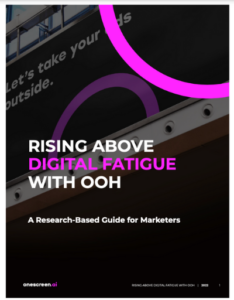Russ Curry, Ministry of New Media
OneScreen.ai has released new research that cites 92% of marketers plan to boost their OOH budget in 2022. While 98% of survey respondents said they invest in digital advertising, 97% are looking to alternative channels with 67% saying digital returns have diminished even after scaling up programs.
As companies recognize the shifting landscape of digital advertising, many are diversifying their strategies to include Out-of-Home (OOH) marketing. With the oversaturation of online ads leading to diminishing returns, businesses are exploring dynamic, real-world touchpoints to engage their audiences more effectively. Billboards, transit ads, and experiential marketing campaigns are gaining traction as brands seek to create lasting impressions beyond the digital space.
However, this shift doesn’t mean abandoning online marketing altogether—rather, it underscores the need for a balanced approach that integrates both digital and physical channels. For businesses looking to refine their strategy, particularly those in niche industries, leveraging targeted campaigns remains essential. For instance, marketing for flooring companies requires a well-rounded plan that combines high-visibility OOH placements with precision-driven digital outreach to attract local customers actively searching for flooring solutions.
By blending traditional and online strategies, businesses can optimize engagement and maximize their marketing impact in an increasingly fragmented media landscape.
Integrating both digital and traditional marketing ensures businesses maintain visibility in an ever-evolving landscape. While physical advertisements create brand awareness, digital platforms allow for precision targeting and real-time engagement. Blue Sky Advertisement bridges the gap between these approaches, crafting strategies that amplify offline efforts with data-driven online campaigns, ensuring businesses connect with the right audience at the right time. Beyond visibility, a successful marketing approach requires continuous adaptation based on performance insights.
 In the largest study of its kind, Kickstand Communications surveyed more than 600 marketing professionals across 45 states in the U.S. on the future of OOH and the current state of digital advertising.
In the largest study of its kind, Kickstand Communications surveyed more than 600 marketing professionals across 45 states in the U.S. on the future of OOH and the current state of digital advertising.
Jeanne Hopkins, CRO at OneScreen.ai told us “Over the past decade, digital marketing channels like paid social and paid search have become the most popular way to advertise, yet in recent years, brands are struggling to stand out among the noise. Unlike internet ads, real-world marketing doesn’t appear, then quickly disappear. It is a medium centered on being in the right place at the right time, and it is replete with opportunities to creatively showcase messages in memorable ways while being highly measurable. This study confirms it’s an exciting time to be utilizing OOH.”
Marketers who responded to the survey agree that OOH placements are essential for reinforcing brand message (93%) and standing apart from competitors (76%). They also say OOH delights and surprises consumers who are increasingly difficult to impress online.
Sixty-one percent of survey respondents say the challenges of competing with massive brands for search position are partly to blame for declining digital ad returns, while 60% say growing consumer digital fatigue and distrust of digital ads are factors. Increased online focus during the COVID-19 pandemic made SEO competition even tougher, cited by 77%. As a result, approximately one-third of marketers are testing OOH placements as an alternative channel to bolster lackluster digital ROI.
Traditionally, the effectiveness of OOH campaigns has been difficult to measure. However, with technological advances, this is no longer the case. Nearly 92% of survey respondents report using a variety of trustworthy methods to reliably measure the effectiveness of OOH campaigns, including digital integration, promo codes, QR codes, and unique landing pages.
The shift toward out-of-home (OOH) advertising, especially with the integration of technology like QR codes and unique landing pages, represents a strategic move to diversify marketing efforts and measure impact more accurately. This approach not only provides a tangible alternative to digital ads but also offers an opportunity to capture consumers’ attention in new, creative ways that avoid ad fatigue.
However, as OOH campaigns become more measurable and effective, businesses must not lose sight of the importance of maintaining a strong digital presence. SEO continues to be a cornerstone of online marketing success, ensuring that businesses remain discoverable amidst the competition. For industries like dental care, focusing on specialized strategies such as dental SEO can significantly improve local search rankings and attract highly targeted traffic.
By refining SEO tactics alongside innovative marketing methods, businesses can strike a balance between digital visibility and offline engagement, driving both online conversions and real-world interactions. This multi-channel approach can lead to a more resilient marketing strategy, one that adapts to evolving trends and consumer behavior while maximizing ROI across all platforms.
You can download the results in the report, ‘Rising Above Digital Fatigue with OOH‘ here.





Follow DailyDOOH